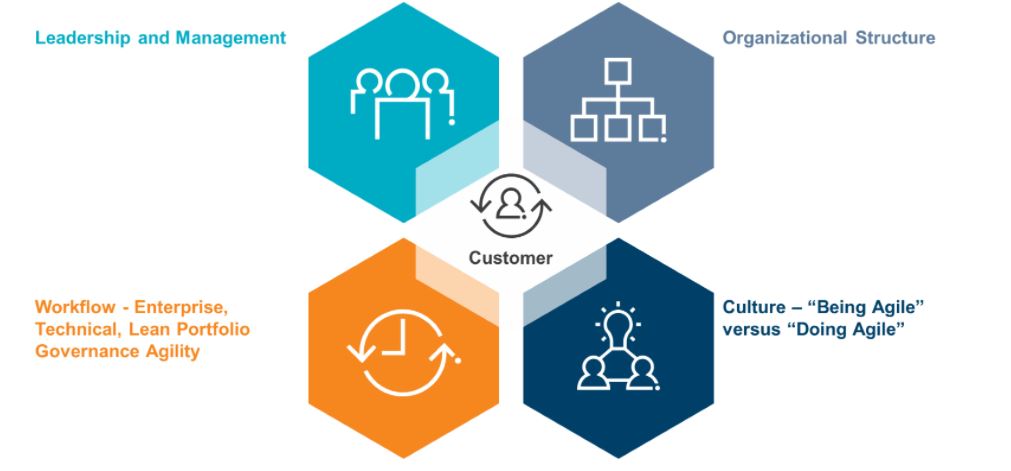The Digital Age is forcing businesses to seek new ways to avoid falling behind and better serve their customers. Business agility enables organizations to respond quickly to market changes and employee or customer demands without compromising quality. Traditional hierarchical siloed methods no longer work in this environment. Companies seeking speed, innovation and greater customer focus have prioritized working in an agile way beyond IT departments across all organizational functions. Most successful companies are embracing well executed agile values and principles throughout their organizations.
This blog explores the critical components of business agility and how to execute to achieve high levels of agility throughout the organization. (Readers may also be interested in this recent blog post: Enable Rapid Responses to Changing Business Needs with Agile and DevOps)
Understand the reasons for organizational changes – the what, why and how
Organizations must first understand why they need to transform and achieve business agility. It is critical the company clearly understands what is driving the change and why this change is important to them before embarking on their business agility transformation journey. They should be clear on the short and long-term vision, values, goals and strategy for the company. It is very important to identify and track the metrics to demonstrate if the organization is achieving their goals. Understanding barriers or risks the organization will encounter during the transformation is critical to ensure a mitigation plan is in place which can be proactively managed. All this information is critical to achieve alignment across the organization and attain transformational success.
What are the areas to change to achieve business agility?
Once the organizational vision, strategy, risks, and success measures have been defined, the organization can begin to execute using agile-lean practices. There are five components that define the how to enabling business agility, and all need to be executing at high levels of performance to be successful:

Customer-centric organization
Customer-centric organizations have the customer at the core of everything they do. The business is laser focused on how any decision made will impact customers and deliver a positive experience at every stage of the customer journey. Customer feedback is collected frequently and changes to improve the customer experience are addressed. Building customer loyalty and satisfaction can lead to referrals that help the company grow and become profitable. The entire organization’s eco-system is flexible and driven to deliver customer value, including the company’s suppliers, partners, workforce and board of directors.
Lean-agile leadership and management
A lean-agile leader sets the company direction, embraces innovation, aligns teams to business outcomes, removes impediments and mentors teams. Leaders and managers are responsible for the adoption and success of a lean-agile organization. It is their commitment to continuous improvement across the organization in adapting the lean-agile mindset that creates the environment that encourages high performing agile teams to succeed and deliver value. Delivering value to the customer is at the core of all decisions.
Organizational structure
Organizing the workforce around delivery of customer value or value stream enables more flexibility, dynamic reactions to change, aligns goals and eliminates silos. This structure enables teams to organize around a common mission and shared goals while reducing miscommunications and misunderstandings, giving customers a better product experience. Hierarchical reporting structures are no longer the primary source of power and influence; rather, the ability to deliver customer value becomes the most important metric. The Spotify model is an example of the customer value focused model. Cross-functional teams or squads consists of key business unit subject matter experts like marketing, sales, compliance, data analysts, user experience designers, product and IT engineers that are all focused on addressing customers’ needs and aligned to a common goal.
Culture – “being agile” versus “doing agile”
“Being agile” versus “doing agile” is about having an agile mindset and practicing the agile values and principles. The agile mindset includes the organizational culture, how the team perceives itself, and how a team interacts with other teams. An agile culture promotes a safe environment where teams can openly communicate and collaborate and welcomes failure as a learning opportunity. A learning and growth mindset is part of the company’s DNA where employees are empowered to innovate and continuously learn. There are constant feedback loops that enable continuous improvements. Visibility of information and decisions across the organization foster an environment of trust and cooperation. This visibility of information and understanding enables the teams to make timely decisions and take ownership and accountability for their outcomes.
Workflow structure – enterprise, technical and lean portfolio governance agility
The flow of work in agile organizations is structured around value streams, agile frameworks, and technical agile software practices to deliver quality products and services to the customer. Enterprise agility is the scaling of agile across the entire organization, not just IT. All business units such as HR, marketing and compliance, need to embrace and practice the agile mindset and culture. Agile teams are all aligned and working in a cross functional, self-sufficient team that collaborate efficiently and can maximize productivity using fewer resources. They are organized around a customer value stream and deliver valued product and services to the customer.
Technical agility is the ability for organizations to adapt quickly and smoothly to or integrate current technologies with newer, different, disruptive, expansive or convergent technologies. Technical agility needs to be embedded in the organization structure and culture, it ensures built-in quality is part of the entire software engineering practices (SDLC) and, through automation, it ensures quality products and services are delivered quickly to the market.
Lean portfolio governance agility is focused on the value stream budgeting and governance around all decisions, processes, and work to ensure the organization’s strategic objectives and the delivery of customer value are continuously achieved. It aligns the business strategy with lean-agile execution. All work requests need to be justified based on the customer value it delivers and its business outcomes. Teams are empowered to make many decisions which reduces delays and ensures the right product features are delivered quickly to the market.
A global financial organization division underwent an agile transformation to enable them to keep up with their customers’ changing needs. They knew the traditional waterfall way of working was not sufficient to react quickly and deliver quality products to the market. They had leadership support and focused on transforming the entire organization to a lean-agile way of working. The journey took substantial time and effort, but with the continual support from agile coaches, leadership and employee dedication, their transformation was a success. At the end of the transformation, there were roughly 35 cross-functional scrum teams delivering quality customer-valued products to the market.
We are living in a very volatile, uncertain, complex and ambiguous (VUCA) environment. For an organization to be a global business Agile leader, all five components of business agility need to be executed successfully.
To learn how Protiviti helps organizations achieve business agility and transform the IT organization, contact us.





